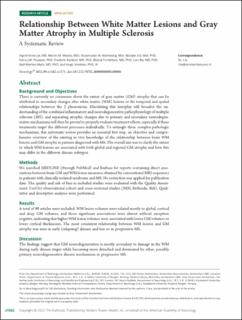| dc.contributor.author | Lie, Ingrid Anne | |
| dc.contributor.author | Weeda, Merlin M. | |
| dc.contributor.author | Mattiesing, Rozemarijn M. | |
| dc.contributor.author | Mol, Marijke A.E. | |
| dc.contributor.author | Pouwels, Petra J.W. | |
| dc.contributor.author | Barkhof, Frederik | |
| dc.contributor.author | Torkildsen, Øivind | |
| dc.contributor.author | Bø, Lars | |
| dc.contributor.author | Myhr, Kjell-Morten | |
| dc.contributor.author | Vrenken, Hugo | |
| dc.date.accessioned | 2022-11-28T15:01:08Z | |
| dc.date.available | 2022-11-28T15:01:08Z | |
| dc.date.created | 2022-10-06T11:11:16Z | |
| dc.date.issued | 2022 | |
| dc.identifier.issn | 0028-3878 | |
| dc.identifier.uri | https://hdl.handle.net/11250/3034577 | |
| dc.description.abstract | Background and Objectives: There is currently no consensus about the extent of gray matter (GM) atrophy that can be attributed to secondary changes after white matter (WM) lesions or the temporal and spatial relationships between the 2 phenomena. Elucidating this interplay will broaden the understanding of the combined inflammatory and neurodegenerative pathophysiology of multiple sclerosis (MS), and separating atrophic changes due to primary and secondary neurodegenerative mechanisms will then be pivotal to properly evaluate treatment effects, especially if these treatments target the different processes individually. To untangle these complex pathologic mechanisms, this systematic review provides an essential first step: an objective and comprehensive overview of the existing in vivo knowledge of the relationship between brain WM lesions and GM atrophy in patients diagnosed with MS. The overall aim was to clarify the extent to which WM lesions are associated with both global and regional GM atrophy and how this may differ in the different disease subtypes.
Methods: We searched MEDLINE (through PubMed) and Embase for reports containing direct associations between brain GM and WM lesion measures obtained by conventional MRI sequences in patients with clinically isolated syndrome and MS. No restriction was applied for publication date. The quality and risk of bias in included studies were evaluated with the Quality Assessment Tool for observational cohort and cross-sectional studies (NIH, Bethesda, MA). Qualitative and descriptive analyses were performed.
Results: A total of 90 articles were included. WM lesion volumes were related mostly to global, cortical and deep GM volumes, and those significant associations were almost without exception negative, indicating that higher WM lesion volumes were associated with lower GM volumes or lower cortical thicknesses. The most consistent relationship between WM lesions and GM atrophy was seen in early (relapsing) disease and less so in progressive MS.
Discussion: The findings suggest that GM neurodegeneration is mostly secondary to damage in the WM during early disease stages while becoming more detached and dominated by other, possibly primary neurodegenerative disease mechanisms in progressive MS. | en_US |
| dc.language.iso | eng | en_US |
| dc.publisher | Wolters Kluwer | en_US |
| dc.rights | Navngivelse 4.0 Internasjonal | * |
| dc.rights.uri | http://creativecommons.org/licenses/by/4.0/deed.no | * |
| dc.title | Relationship between White Matter Lesions and Gray Matter Atrophy in Multiple Sclerosis | en_US |
| dc.type | Journal article | en_US |
| dc.type | Peer reviewed | en_US |
| dc.description.version | publishedVersion | en_US |
| dc.rights.holder | Copyright 2022 the authors | en_US |
| cristin.ispublished | true | |
| cristin.fulltext | original | |
| cristin.qualitycode | 2 | |
| dc.identifier.doi | 10.1212/WNL.0000000000200006 | |
| dc.identifier.cristin | 2059084 | |
| dc.source.journal | Neurology | en_US |
| dc.source.pagenumber | E1562-E1573 | en_US |
| dc.identifier.citation | Neurology. 2022, 98 (15), E1562-E1573. | en_US |
| dc.source.volume | 98 | en_US |
| dc.source.issue | 15 | en_US |

